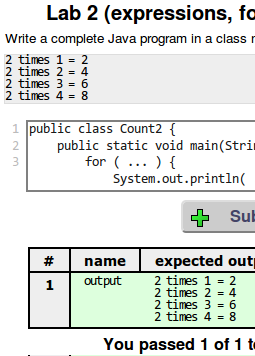

The Favorites window is not designed for full-scale project development, but it can be useful if you just want to open and edit a few files quickly. The Favorites window enables you to make arbitrary folders and files on your system accessible through the IDE. If you would simply like to create a file without setting up a project, you can use the Favorites window. See Chapter 3 for basic information on creating projects and files and for a description of the various file templates. You can then open an existing file or create a new file from a template. Opening the Source Editorīefore starting to work in the Source Editor, you will typically want to have an IDE project set up. In this chapter, we will demonstrate the ways you can use the IDE's editing features to simplify and speed common coding tasks. When compilation errors are reported in the Output window, you can jump to the source of those errors by double-clicking the error or pressing F12.
#Jgrasp line numbers code#
For example, you can specify breakpoints directly in the Source Editor and trace code as it executes. Perhaps most importantly, the Source Editor is tightly integrated with other parts of the IDE, which greatly streamlines your workflow. properties, deployment descriptor, and other types of files, you get a set of features specific to those files. For example, when you open a Java file, there is a syntax highlighting scheme specifically for Java files, along with code completion, refactoring, and other features specific to Java files. Keyboard shortcuts for these code generation features and for file navigation ensure that your hands rarely have to leave the keyboard.Īrchitecturally, the Source Editor is a collection of different types of editors, each of which contains features specific to certain kinds of files.

Refactoring features enable you to easily make complex changes to the structure of your code and have those changes propagated throughout your project. Given that fact, a lot of attention has been put into features and subtle touches to make coding faster and more pleasurable.Ĭode completion and other code generation features help you identify code elements to use and then generate code for you. NETBEANS IDE PROVIDES A WIDE VARIETY OF TOOLS to support Java application development, but it is the Source Editor where you will spend most of your time. KEEGAN:NETBEANS IDE FIELD GUIDE _p2, 2nd Edition Changing Source Editor Keyboard Shortcuts.Comparing Differences Between Two Files.Tracking Notes to Yourself in Your Code.Extracting a Superclass to Consolidate Common Methods.Creating an Interface from Existing Methods.Creating a Method from Existing Statements.Navigating within the Current Java File.Displaying Javadoc Documentation While Editing.Creating and Customizing File Templates.Generating Methods to Implement and Override.Using Editor Hints to Generate Missing Code.Generating Code Snippets without Leaving the Keyboard.Managing Automatic Insertion of Closing Characters.


 0 kommentar(er)
0 kommentar(er)
